Part 3 – Currency Exhibition
Coins used in the Land of Israel and Jewish minting in ancient times: from the return to Zion to the Ottoman period.
The idea of minting coins reached our shores later on, about 200 years after the invention of coinage, during the Persian period. The first coins to be minted in Israel were produced in the 5th century BCE.
Coins were first minted in the coastal area (Gaza, Ashkelon, and Ashdod), and then in Samaria and Judea. Jews began minting coins in the 4th century BCE, when coins were also first minted in Jerusalem.
Over the past 2500 years, coins circulating in Israel included those minted by Jews during periods of independence or of rebellion against foreign occupiers and striving for independence, as well as those minted by non-Jewish rulers both in Israel and abroad.
The idea of minting coins reached our shores later on, about 200 years after the invention of coinage, during the Persian period. The first coins to be minted in Israel were produced in the 5th century BCE.
Coins were first minted in the coastal area (Gaza, Ashkelon, and Ashdod), and then in Samaria and Judea. Jews began minting coins in the 4th century BCE, when coins were also first minted in Jerusalem.
Over the past 2500 years, coins circulating in Israel included those minted by Jews during periods of independence or of rebellion against foreign occupiers and striving for independence, as well as those minted by non-Jewish rulers both in Israel and abroad.
The first Jewish coins minted in Israel - Return to Zion, and the Persian period (538–333 BCE)
The first coins minted by Jews in ancient times were minted in Israel under foreign rule. These coins were made of silver, and most of them were very small. The inscriptions on the coins were generally in ancient Hebrew, and sometimes in Aramaic.
Did you know?
Following the declaration by Koresh (King of Persia), many of those exiled by the Babylonian empire returned to Israel. They brought with them the Aramaic language and the squared Jewish script that we use today. However, almost all Jewish coins from ancient times bear an inscription in the ancient Jewish script that was commonly used during the First Temple era until the Babylonian exile.
Pictured:
A very small silver coin bearing the inscription “YHD” (Jerusalem, 4th century BCE);
One side bears an image of a lily, and the other bears an image of an eagle spreading its wings with the inscription “YHD” in ancient Hebrew script, signifying “Judea” during the Persian period.
Did you know?
The current NIS 1 coin of the State of Israel (Agorot and New Shekel series issued since 1985) was inspired by this coin. The inscription “YHD” in ancient Hebrew script appears on it, alongside the lily. Ancient Hebrew inscriptions also appear on other modern coins of the same series (5 agorot (now discontinued) and NIS 10).
Did you know?
Following the declaration by Koresh (King of Persia), many of those exiled by the Babylonian empire returned to Israel. They brought with them the Aramaic language and the squared Jewish script that we use today. However, almost all Jewish coins from ancient times bear an inscription in the ancient Jewish script that was commonly used during the First Temple era until the Babylonian exile.
Pictured:
A very small silver coin bearing the inscription “YHD” (Jerusalem, 4th century BCE);
One side bears an image of a lily, and the other bears an image of an eagle spreading its wings with the inscription “YHD” in ancient Hebrew script, signifying “Judea” during the Persian period.
Did you know?
The current NIS 1 coin of the State of Israel (Agorot and New Shekel series issued since 1985) was inspired by this coin. The inscription “YHD” in ancient Hebrew script appears on it, alongside the lily. Ancient Hebrew inscriptions also appear on other modern coins of the same series (5 agorot (now discontinued) and NIS 10).

Hellenic period (333–168 BCE)
Alexander the Great, leading an army of Greeks and Macedonians, waged war against the Persian Empire and conquered most of its territory. As a result, Hellenic culture developed as a combination of ancient Greek culture and cultures of the ancient east, including those from our region.
Alexander was the first ruler who understood the power of coinage as a publicity tool. His coins, bearing his image, were very popular throughout the ancient world. From his time onward, the ruler’s image became a frequent feature on coins.
Top pictures:
A tetradrachma of Alexander the Great, minted in Acco. The obverse bears the head of Alexander wearing a lion’s skin (similar to Hercules), and the reverse bears a likeness of Zeus sitting on his throne.
Alexander was the first ruler who understood the power of coinage as a publicity tool. His coins, bearing his image, were very popular throughout the ancient world. From his time onward, the ruler’s image became a frequent feature on coins.
Top pictures:
A tetradrachma of Alexander the Great, minted in Acco. The obverse bears the head of Alexander wearing a lion’s skin (similar to Hercules), and the reverse bears a likeness of Zeus sitting on his throne.
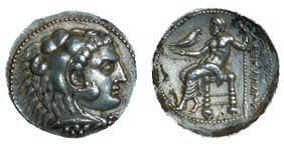
Bottom pictures:
A Tyrolean pound (silver coin of the city of Tyre). The obverse bears a likeness of the Greek hero Hercules, and the reverse bears a likeness of an eagle grasping a ship’s bow – a symbol of Tyre’s maritime power. The Greek inscription on the coin reads “Holy Tyre – City of Refuge”
Did you know?
The Tyrolean pound is a coin that was used from the later Hellenic period until the Great Revolt for the “Half-Shekel” donations in the Second Temple. It was chosen for its high percentage of pure silver.
A Tyrolean pound (silver coin of the city of Tyre). The obverse bears a likeness of the Greek hero Hercules, and the reverse bears a likeness of an eagle grasping a ship’s bow – a symbol of Tyre’s maritime power. The Greek inscription on the coin reads “Holy Tyre – City of Refuge”
Did you know?
The Tyrolean pound is a coin that was used from the later Hellenic period until the Great Revolt for the “Half-Shekel” donations in the Second Temple. It was chosen for its high percentage of pure silver.

Hasmonean dynasty (168–37 BCE)
The Hasmonean revolt against the Seleucid reime (168 BCE and onward) broke out due to various decrees and changes that the Seleucids imposed on the Jewish community in Israel. The revolt was led by Mattathias and his sons from Modi’in, against Antiochus IV Epiphanes. Judah the Macabee and his brothers led the rebels to victory, the cancellation of the religious decrees, the purification of the Temple, and Jewish independence. As a result of that independence achieved by the Hasmonean dynasty, Jewish coins were minted under an independent Jewish government for the first time. The first Hasmoenan ruler who minted coins was John Hyrkanus I (around 127 BCE), and one of the first coins he minted bore a likeness of a double cornucopia with a pomegranate between the horns. All of the Hasmonean coins were made of bronze, and most were of uniform size and value (1 pruta). At first, the coins contained ancient Hebrew inscriptions, and later on Greek inscriptions as well.
Upper picture:
A bronze coin of John Hyrkanus I, bearing a double cornucopia with a pomegranate between the horns on the obverse side, and an ancient Hebrew inscription within a wreath on the reverse side: “John the High Priest and Friend of the Jews”.
Did you know?
This coin of John Hyrkanus, bearing a double cornucopia with a pomegranate between the horns was the inspiration for the design of the modern NIS 2 coin.
Upper picture:
A bronze coin of John Hyrkanus I, bearing a double cornucopia with a pomegranate between the horns on the obverse side, and an ancient Hebrew inscription within a wreath on the reverse side: “John the High Priest and Friend of the Jews”.
Did you know?
This coin of John Hyrkanus, bearing a double cornucopia with a pomegranate between the horns was the inspiration for the design of the modern NIS 2 coin.

Lower picture:
Copy of a bronze coin from Mattathias Antigonous, last of the Hasmonean rulers.
The obverse bears a likeness of the seven-branched Menorah from the Temple, and the reverse bears a likeness of the Shewbread table.
Does this coin look familiar?
This coin from Mattathias Antigonous, bearing a likeness of the seven-branched Menorah, was the inspiration for the NIS 100 shekel coin from the New Agorot and Shekel series, and for the 10 agorot coin from the Agorot and New Shekel series that has been in circulation in Israel since 1985.
Did you know?
From the Hasmonean coins onward, almost all Jewish coins do not bear likenesses of people or animals.
Copy of a bronze coin from Mattathias Antigonous, last of the Hasmonean rulers.
The obverse bears a likeness of the seven-branched Menorah from the Temple, and the reverse bears a likeness of the Shewbread table.
Does this coin look familiar?
This coin from Mattathias Antigonous, bearing a likeness of the seven-branched Menorah, was the inspiration for the NIS 100 shekel coin from the New Agorot and Shekel series, and for the 10 agorot coin from the Agorot and New Shekel series that has been in circulation in Israel since 1985.
Did you know?
From the Hasmonean coins onward, almost all Jewish coins do not bear likenesses of people or animals.
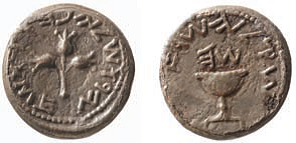
Herodian dynasty (40 BCE–44 CE)
In the year 37 BCE, Mattathias Antigonos was defeated by Herod, who conquered Jerusalem and put an end to the Hasmonean dynasty. Most of the coins minted by Herod were small and modest. Some of them continued to bear images from the Hasmonean dynasty, and some bore new designs. They were all made of only bronze. His coins were the first Jewish coins to bear only Greek inscriptions.
Pictured:
A bronze coin from King Herod.
The obverse bears a double cornucopia, with a caduceus. The reverse bears the likeness of an anchor.
Did you know?
King Herod was the greatest of the builders in ancient Israel. However, his coins are not at all impressive, and bear no evidence of his gloried image.
Pictured:
A bronze coin from King Herod.
The obverse bears a double cornucopia, with a caduceus. The reverse bears the likeness of an anchor.
Did you know?
King Herod was the greatest of the builders in ancient Israel. However, his coins are not at all impressive, and bear no evidence of his gloried image.
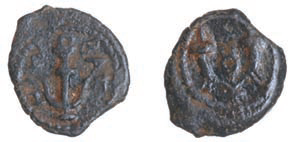
Herod’s grandson, Agrippas I, the last king of Judea, minted a variety of coins, all from Bronze and all bearing Greek inscriptions.
The most common coin minted by Agrippas was minted in Jerusalem in the years 41/42 CE, and bore a likeness of three ears of grain on one side, and a royal galley (as an alternative representation of the king) on the other.
Pictured:
A bronze coin of Agrippas I minted in Jerusalem. A royal galley on the obverse, and a bushel of grain on the reverse.
Did you know?
This coin was the inspiration for one of the most famous coins of the State of Israel – the 1 Agora coin with milled edge issued in 1960.
The most common coin minted by Agrippas was minted in Jerusalem in the years 41/42 CE, and bore a likeness of three ears of grain on one side, and a royal galley (as an alternative representation of the king) on the other.
Pictured:
A bronze coin of Agrippas I minted in Jerusalem. A royal galley on the obverse, and a bushel of grain on the reverse.
Did you know?
This coin was the inspiration for one of the most famous coins of the State of Israel – the 1 Agora coin with milled edge issued in 1960.
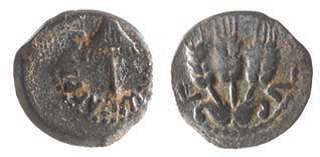
Roman period – Mishnaic period (1st–4th centuries CE)
During the Roman period, a variety of coins circulated in Israel. Some of them were imperial, and some were provincial (coins minted in the provinces of the Roman Empire and not by the Roman authorities themselves. The bronze coins minted in local “polities” bore a Greek inscription, while those minted in the colonies bore a Latin inscription.
Significant trade included the use of gold and silver coins that were minted at the various imperial mints in Rome or in the East.
Picture:
A bronze coin of the Aelia Capitolina colony (Jerusalem), minted by the Roman authorities in the city. The obverse carries a likeness of the Roman Caesar Marcus Aurelius, and the reverse carries a likeness of the god Zeus Serapis sitting on a throne.
Did you know?
During the Roman period (1st century BCE–3rd century CE), there were at least 40 cities in Israel that minted their own coins, mostly out of bronze. The minting took place during various periods, and was not constant. The coins minted in the cities did not carry any denomination, and most of them did not bear any dates.
Significant trade included the use of gold and silver coins that were minted at the various imperial mints in Rome or in the East.
Picture:
A bronze coin of the Aelia Capitolina colony (Jerusalem), minted by the Roman authorities in the city. The obverse carries a likeness of the Roman Caesar Marcus Aurelius, and the reverse carries a likeness of the god Zeus Serapis sitting on a throne.
Did you know?
During the Roman period (1st century BCE–3rd century CE), there were at least 40 cities in Israel that minted their own coins, mostly out of bronze. The minting took place during various periods, and was not constant. The coins minted in the cities did not carry any denomination, and most of them did not bear any dates.
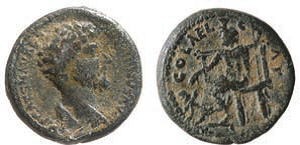
Roman governors in Judea (6–66 CE)
Following Herod’s death and the weakening of his heirs, direct Roman control of Israel increased. The Roman governors that controlled Judea between the years 6 and 66 CE minted coins for local needs. These coins, which were mainly intended for use by the Jewish population, lack pagan symbols or portraits.
Pictured: A pruta coin from the Valerius Geratus period (15–26 CE). One side bears a likeness of a date palm branch, and the other bears a likeness of a wreath containing the name of Emperor Tiberius.
Pictured: A pruta coin from the Valerius Geratus period (15–26 CE). One side bears a likeness of a date palm branch, and the other bears a likeness of a wreath containing the name of Emperor Tiberius.

The Jewish war against the Romans (66–70 CE)
In the year 66, the Jews began a struggle against the Roman rulers in Israel, with the aim of evicting the Roman army from Judea and establishing an independent Jewish state.
During the five-year-long war, the rebel authorities minted a series of coins made of silver and bronze, which bore inscriptions in only ancient Hebrew script and clear Jewish symbols that were mainly connected with the Temple service. The very act of minting coins during a struggle is a political declaration—an expression of national freedom and independence. This is particularly true when minting in silver, since the right to mint with that metal was reserved for the Caesar alone.
The silver coins that were minted during the war were the only Jewish coins in ancient times to carry a denomination (shekel, half-shekel, and quarter shekel), and were among the only Jewish coins to bear a date. The silver coins of the first and fifth years are the rarest in this group. The war ended with the destruction of the Second Temple and of Jerusalem.
Upper Picture: A silver coin from the first year of the war, minted in Jerusalem. One side shows a goblet surrounded with the words “Israeli Shekel” and a letter “Aleph” above the goblet representing the first year (66/67 CE) of the revolt. The other side shows a bunch of pomegranates and the words “Holy Jerusalem”.
During the five-year-long war, the rebel authorities minted a series of coins made of silver and bronze, which bore inscriptions in only ancient Hebrew script and clear Jewish symbols that were mainly connected with the Temple service. The very act of minting coins during a struggle is a political declaration—an expression of national freedom and independence. This is particularly true when minting in silver, since the right to mint with that metal was reserved for the Caesar alone.
The silver coins that were minted during the war were the only Jewish coins in ancient times to carry a denomination (shekel, half-shekel, and quarter shekel), and were among the only Jewish coins to bear a date. The silver coins of the first and fifth years are the rarest in this group. The war ended with the destruction of the Second Temple and of Jerusalem.
Upper Picture: A silver coin from the first year of the war, minted in Jerusalem. One side shows a goblet surrounded with the words “Israeli Shekel” and a letter “Aleph” above the goblet representing the first year (66/67 CE) of the revolt. The other side shows a bunch of pomegranates and the words “Holy Jerusalem”.
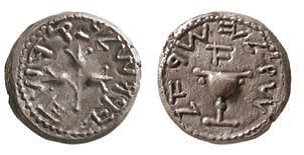
Lower picture:
A silver coin from the fifth year of the war, minted in Jerusalem. One side shows a goblet surrounded with the words “Israeli Shekel” and the letters “Shin-Heh” above the goblet representing the fifth year (70/71 CE) of the revolt. The other side shows a bunch of pomegranates and the words “Holy Jerusalem”.
Did you know?
The shekel and half-shekel coins of the war were the inspiration for the Israeli lira coin issued in 1967 and the 1-shekel coin issued in 1981.
A silver coin from the fifth year of the war, minted in Jerusalem. One side shows a goblet surrounded with the words “Israeli Shekel” and the letters “Shin-Heh” above the goblet representing the fifth year (70/71 CE) of the revolt. The other side shows a bunch of pomegranates and the words “Holy Jerusalem”.
Did you know?
The shekel and half-shekel coins of the war were the inspiration for the Israeli lira coin issued in 1967 and the 1-shekel coin issued in 1981.

Bar Kochva Revolt (132–135 CE)
Between 120 and 130 CE, the Roman government under the Caesar Hadrian began rebuilding Jerusalem as an idolatrous Roman city named “Aelia Capitolina”, including the construction of a temple to Jupiter, apparently meant to be built on the Temple Mount. The Jewish community organized under the leadership of Shimon Bar Coziva (Bar Kochva) and rebelled against the Romans. The name of the rebellion’s leader, Shimon, appears on the coins with the title “President of Israel”. During the rebellion, the rebels minted a rich and varied series of coins.
The coins were minted in silver and bronze, mainly over Roman coins that were circulating at the time. The rebel coins bore inscriptions in ancient Hebrew script only, and Jewish symbols connected with the Temple service, as a political declaration and an expression of independence. Some of the inscriptions on the coins included slogans to encourage the people, such as “to Israel’s salvation”, and “to Israel’s freedom”.
This was the most impressive, and last, issue to be minted by Jews in ancient times.
The rebellion ended with the national destruction of the Jewish community in Israel and the loss of Jewish independence in Israel, until the establishment of the modern State of Israel in 1948.
Upper picture:
A sela (tetradrachma) – a large silver coin from the time of the Bar Kochva Revolt, minted in Judea, bearing a clear and unique Jewish symbol: the façade of the Temple and the inscription “Jerusalem”. The flip side of the coin showed the Four Species surrounded by the words “Second Year of Israel’s Freedom”
The coins were minted in silver and bronze, mainly over Roman coins that were circulating at the time. The rebel coins bore inscriptions in ancient Hebrew script only, and Jewish symbols connected with the Temple service, as a political declaration and an expression of independence. Some of the inscriptions on the coins included slogans to encourage the people, such as “to Israel’s salvation”, and “to Israel’s freedom”.
This was the most impressive, and last, issue to be minted by Jews in ancient times.
The rebellion ended with the national destruction of the Jewish community in Israel and the loss of Jewish independence in Israel, until the establishment of the modern State of Israel in 1948.
Upper picture:
A sela (tetradrachma) – a large silver coin from the time of the Bar Kochva Revolt, minted in Judea, bearing a clear and unique Jewish symbol: the façade of the Temple and the inscription “Jerusalem”. The flip side of the coin showed the Four Species surrounded by the words “Second Year of Israel’s Freedom”

Lower picture:
A large bronze coin minted in Judea. The obverse side shows an amphora (one of the Temple vessels) surrounded by the inscription “first year of Israel’s salvation”, and the reverse shows a wreath with the inscription “Shimon President of Israel”.
This coin was the inspiration for the 10 pruta coin issued in 1949.
Did you know?
All of the Bar Kochva Revolt coins were minted over existing coins that were in circulation when the rebellion began. This was a clear political statement of the desire to replace the Roman regime.
A large bronze coin minted in Judea. The obverse side shows an amphora (one of the Temple vessels) surrounded by the inscription “first year of Israel’s salvation”, and the reverse shows a wreath with the inscription “Shimon President of Israel”.
This coin was the inspiration for the 10 pruta coin issued in 1949.
Did you know?
All of the Bar Kochva Revolt coins were minted over existing coins that were in circulation when the rebellion began. This was a clear political statement of the desire to replace the Roman regime.

From the Bar Kochva Revolt to the modern State of Israel: The first coin of the State of Israel
The first coin of the State of Israel, the 25 mil coin from 1948, is adorned with a likeness of a cluster of grapes taken from the Bar Kochva coins.
Upper picture:
The first coin of the State of Israel (1948).
Upper picture:
The first coin of the State of Israel (1948).
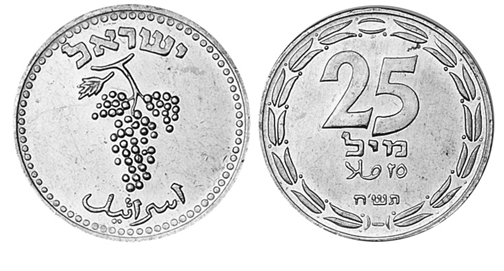
Lower picture:
A bronze coin from the first year of the Bar Kochva Revolt (132/3 CE), which was the inspiration for the first coin of the State of Israel.
A bronze coin from the first year of the Bar Kochva Revolt (132/3 CE), which was the inspiration for the first coin of the State of Israel.

Byzantine period – Talmudic period (324–640 CE)
Once Christianity became the official religion of the Roman Empire, the nature of the coins minted by the government changed. Instead of images of popular gods such as Zeus, the coins started to carry symbols such as crosses as well as denominations. During the Byzantine period, there were almost no coins minted in the Land of Israel at all, and most of the coins used were made of bronze and gold and came from various mints throughout the Byzantine empire.
Pictured:
A bronze coin of the Byzantine Caesar Justinian II, minted in the city of Nicomedia (now in Turkey). The obverse features a likeness of Justinian and his wife Sophia sitting on thrones. The reverse bears the denomination M (40 nummi = 1 follis), above the name of the mint (nicomedia), with the date (year 10) to the right and left.
Pictured:
A bronze coin of the Byzantine Caesar Justinian II, minted in the city of Nicomedia (now in Turkey). The obverse features a likeness of Justinian and his wife Sophia sitting on thrones. The reverse bears the denomination M (40 nummi = 1 follis), above the name of the mint (nicomedia), with the date (year 10) to the right and left.
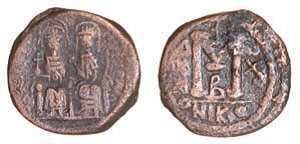
Early Muslim Period (640–1099 CE)
Following the Arab conquest of Israel (640 CE), there were various changes in the country, including with regard to the minting of local coins. From the mid-7th century onward, bronze coins were minted in various locations in Israel. At first, the coins mimicked the Byzantine coins, and even bore Greek inscriptions and images. Following the reform by the ruler Abd Al-Malik (696 CE), most coins no longer bore images, in accordance with the Muslim prohibition. Rather, the coins bore only Arabic inscriptions, including quotes from the Quran. The reform also set out a series of three denominations: a gold dinar, a silver dirham, and a bronze fals.
Upper picture: A bronze coin from the Umayyad dynasty, minted in Israel by the Muslim government (c 700 CE). One side bears the inscription of the Shihada (“There is no god but Allah alone”), and the other bears the inscription “Muhammad is the apostle of Allah”).
Upper picture: A bronze coin from the Umayyad dynasty, minted in Israel by the Muslim government (c 700 CE). One side bears the inscription of the Shihada (“There is no god but Allah alone”), and the other bears the inscription “Muhammad is the apostle of Allah”).

Lower picture:
A coin minted in Ramla bearing an image of a palm frond surrounded by the inscription, “There is no god but Allah alone”. The reverse bears an image of a crescent with the surrounding inscription, “This coin was minted in Ramla”.
Did you know?
Like Jews, Muslims have almost completely avoided showing images of people or animals on their coins.
A coin minted in Ramla bearing an image of a palm frond surrounded by the inscription, “There is no god but Allah alone”. The reverse bears an image of a crescent with the surrounding inscription, “This coin was minted in Ramla”.
Did you know?
Like Jews, Muslims have almost completely avoided showing images of people or animals on their coins.

The Crusader period (1100–1187 CE)
This period began in Israel with the Crusader conquest of Jerusalem, and ended with the fall of Atlit and Acco to the Ayyubid military. With the establishment of the Crusader Kingdom of Jerusalem, silver and bronze coins were minted with the names of several Crusader kings. Most bore an image of the cross. The inscriptions on these coins are mostly in Medieval Latin.
Pictured:
A silver Crusader coin minted in Jerusalem from the days of King Baldwin the Great (1143–1163 CE). One side shows the cross and the inscription “King Baldwin”, while the other shows the Tower of David and the inscription “of Jerusalem”.
Did you know?
Most coins from the Crusader Kingdom of Jerusalem show important buildings in Jerusalem (Tower of David, Church of the Holy Sepulchre, Dome of the Rock). Because of the high cost of the Crusader campaigns, coins of low-quality silver that were particularly thin were minted.
Pictured:
A silver Crusader coin minted in Jerusalem from the days of King Baldwin the Great (1143–1163 CE). One side shows the cross and the inscription “King Baldwin”, while the other shows the Tower of David and the inscription “of Jerusalem”.
Did you know?
Most coins from the Crusader Kingdom of Jerusalem show important buildings in Jerusalem (Tower of David, Church of the Holy Sepulchre, Dome of the Rock). Because of the high cost of the Crusader campaigns, coins of low-quality silver that were particularly thin were minted.
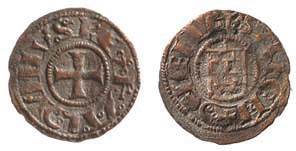
The Ayyubid (1187–1250 CE) and Mamluk (1260–1517) periods
The Ayyubids were Sunni Muslims of Kurdish origin. The Ayyubid dynasty developed in Egypt following the fall of the Fatimid dynasty, and reached its peak in the days of Sallah a-Din beginning in 1171. The Mamluks were non-Arab Muslims based in Cairo. During the Ayyubid and Mamluk regimes, coins were not minted in Israel, and the main coins used were of bronze and silver and originated in Egypt and Syria.
In 1517, the Mamluks were defeated by the Ottomans, and the Land of Israel fell under Ottoman rule.
Pictured:
A bronze coin from the Mamluk period minted in the city of Homs in Syria during the reign of Ashraf Sha’aban II (1363–1377 CE). One side shows a six-pointed star (identified as the seal of Solomon), and the other bears the name of the ruler and the mint stamp.
In 1517, the Mamluks were defeated by the Ottomans, and the Land of Israel fell under Ottoman rule.
Pictured:
A bronze coin from the Mamluk period minted in the city of Homs in Syria during the reign of Ashraf Sha’aban II (1363–1377 CE). One side shows a six-pointed star (identified as the seal of Solomon), and the other bears the name of the ruler and the mint stamp.

The Ottoman period (1517–1917)
From the conquest of the land by Salim I (father of Suleiman the Great) in 1517 until the British conquest in 1917, the Land of Israel was under Ottoman rule. During this period, no coins were minted in Israel, and most coins that were in circulation in Israel came from Constantinople (today Istanbul).
Pictured:
A silver coin from the Ottoman period, minted in Constantinople in 1773. One side bears an Arabic inscription praising the sultan, and the other bears a “Tughra” with the place and year of minting. The hole shows that the coin was also worn as an ornament.
Did you know?
The Tughra that appears on most Ottoman coins is a calligraphic insignia of the ruling sultan.
Pictured:
A silver coin from the Ottoman period, minted in Constantinople in 1773. One side bears an Arabic inscription praising the sultan, and the other bears a “Tughra” with the place and year of minting. The hole shows that the coin was also worn as an ornament.
Did you know?
The Tughra that appears on most Ottoman coins is a calligraphic insignia of the ruling sultan.
